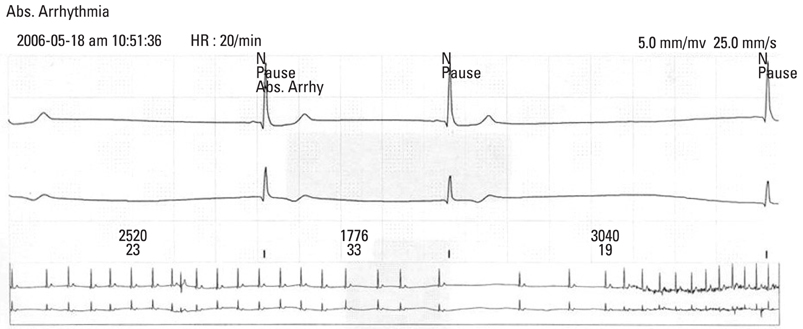Yonsei Med J.
2009 Oct;50(5):729-731. 10.3349/ymj.2009.50.5.729.
Isolated Petroclival Craniopharyngioma with Aggressive Skull Base Destruction
- Affiliations
-
- 1Department of Radiology, Korea University College of Medicine, Seoul, Korea.
- 2Department of Neurosurgery, Korea University College of Medicine, Seoul, Korea. neuron19@korea.ac.kr
- 3Department of Pathology, Korea University College of Medicine, Seoul, Korea.
- KMID: 1103832
- DOI: http://doi.org/10.3349/ymj.2009.50.5.729
Abstract
- We report a rare case of petroclival craniopharyngioma with no connection to the sellar or suprasellar region. MRI and CT images revealed a homogenously enhancing retroclival solid mass with aggressive skull base destruction, mimicking chordoma or aggressive sarcoma. However, there was no calcification or cystic change found in the mass. Here, we report the clinical features and radiographic investigation of this uncommon craniopharyngioma arising primarily in the petroclival region.
Keyword
MeSH Terms
Figure
Reference
-
1. McLendon RE, Rosenblum MK, Bigner DD. Russell and Rubinstein's pathology of tumors of the nervous system. 1998. 6th ed. London: A Hodder Arnold Publication.2. Ragoowansi AT, Piepgras DG. Postoperative ectopic craniopharyngioma. Case report. J Neurosurg. 1991. 74:653–655.3. Tomita S, Mendoza ND, Symon L. Recurrent craniopharyngioma in the posterior fossa. Br J Neurosurg. 1992. 6:587–590.
Article4. Goldberg GM, Eshbaugh DE. Squamous cell nests of the pituitary gland as related to the origin of craniopharyngiomas. A study of their presence in the newborn and infants up to age four. Arch Pathol. 1960. 70:293–299.5. McGrath P. Aspects of the human pharyngeal hypophysis in normal and anencephalic fetuses and neonates and their possible significance in the mechanism of its control. J Anat. 1978. 127:65–81.6. Cooper PR, Ransohoff J. Craniopharyngioma originating in the sphenoid bone. Case report. J Neurosurg. 1972. 36:102–106.7. Benitez WI, Sartor KJ, Angtuaco EJ. Craniopharyngioma presenting as a nasopharyngeal mass: CT and MR findings. J Comput Assist Tomogr. 1988. 12:1068–1072.8. Kanungo N, Just N, Black M, Mohr G, Glikstein R, Rochon L. Nasopharyngeal craniopharyngioma in an unusual location. AJNR Am J Neuroradiol. 1995. 16:1372–1374.9. Solarski A, Panke ES, Panke TW. Craniopharyngioma in the pineal gland. Arch Pathol Lab Med. 1978. 102:490–491.10. Linden CN, Martinez CR, Gonzalvo AA, Cahill DW. Intrinsic third ventricle craniopharyngioma: CT and MR findings. J Comput Assist Tomogr. 1989. 13:362–363.11. Jiang RS, Wu CY, Jan YJ, Hsu CY. Primary ethmoid sinus craniopharyngioma: a case report. J Laryngol Otol. 1998. 112:403–405.12. Altinörs N, Senveli E, Erdoğan A, Arda N, Pak I. Craniopharyngioma of the cerebellopontine angle. Case report. J Neurosurg. 1984. 60:842–844.13. Bashir EM, Lewis PD, Edwards MR. Posterior fast craniopharyngioma. Br J Neurosurg. 1996. 10:613–615.14. Gökalp HZ, Egemen N, Ildan F, Bacaci K. Craniopharyngioma of the posterior fossa. Neurosurgery. 1991. 29:446–448.
Article15. Link MJ, Driscoll CL, Giannini C. Isolated, giant cerebellopontine angle craniopharyngioma in a patient with Gardner syndrome: case report. Neurosurgery. 2002. 51:221–225. discussion 225-6.
Article16. Sener RN. Giant craniopharyngioma extending to the anterior cranial fossa and nasopharynx. AJR Am J Roentgenol. 1994. 162:441–442.
Article17. Eldevik OP, Blaivas M, Gabrielsen TO, Hald JK, Chandler WF. Craniopharyngioma: radiologic and histologic findings and recurrence. AJNR Am J Neuroradiol. 1996. 17:1427–1439.
- Full Text Links
- Actions
-
Cited
- CITED
-
- Close
- Share
- Similar articles
-
- Extensive Transbasal Approach to Skull Base Tumor
- Modified Transpertrosal(mini-petrosal) Approach to Petroclival Tumors: Technical Note
- A Case of Massive Skull Base Erosion by Fungus Ball in the Sphenoid Sinus
- Hearing Preservation with the Transcrusal Approach to the Skull Base Lesion Combined with Other Transcranial Approach: Results of Consecutive Series of 5 Cases
- A Case of Isolated Unilateral Abducens Nerve Palsy Caused by Clival Metastasis from Rectal Cancer




